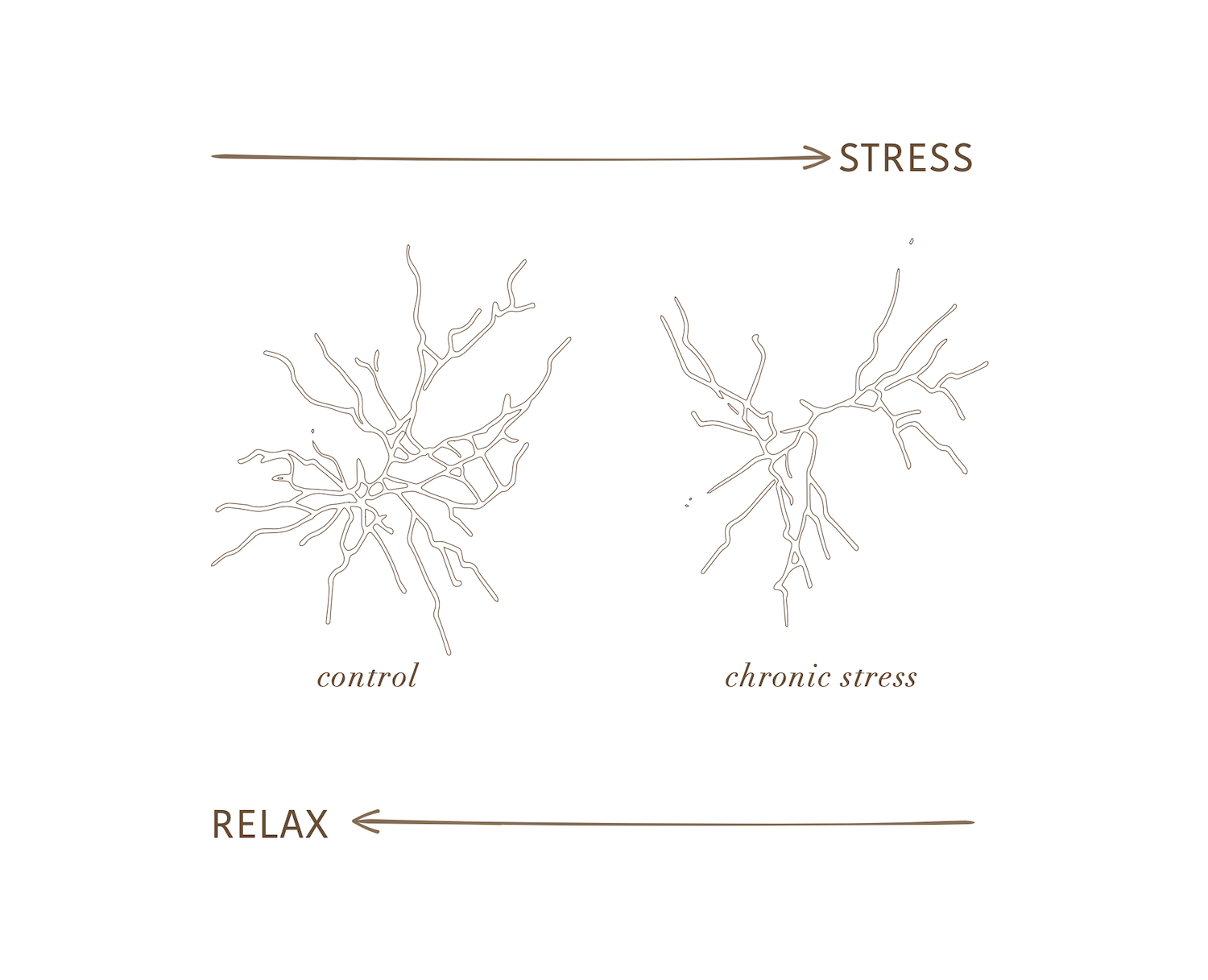Burnout, Cortisol and Your Neurons
For anyone who has wondered, as you go to bed at night, what the impact of stress is on your intricate nervous system . . .
Sometimes, do you find yourself wondering if trouble making a decision, slowed thinking, or feeling like you don’t have many options may be linked to stress?
At the end of the day, do you notice a mental fatigue and wonder how you can prevent this?
Are you curious about the biological impact of longer term stress and how to reverse this?
In the last two years, at least 66% of North Americans in specific areas of work have reported experiencing burnout; 25% to 36% have reported high stress. The guidelines for managing stress speak to work-life balance, better boundaries, improved sleep and use of mindfulness but fairly often, these approaches are not enough.
Those of us on the forefront of the wellness science of burnout and recovery from prolonged stress, are bringing in new tools to help you restore and renew your nervous system. In this article, find out more.
article Summary
a brief review of burnout statistics
prolonged stress and your neurons
cortisol and stress
burnout and chronic stress
tools for burnout recovery
Burnout: The Numbers
In the last two years, 49% or more of health care providers have experienced burnout, and 43% have experienced work overload in the US. In Canada, 66% of nurses experienced burnout in the last two years. Mental health providers in Canada surveyed reported burnout in 61%. Respective numbers for professions with higher than average levels of burnout in Canada were as follows (Source: Psychological Health and Safety in Canadian Workplaces: December 2021 Results):
Health and patient care: 53 per cent
Transportation: 40 per cent
Finance, legal and insurance: 39 per cent
Education and childcare: 38 per cent
First responders: 36 per cent.
In Canada, in the general population, 25% of Canadians experienced high levels of stress, especially in women and those aged 25 to 54 years old - in this age range, up to 36% were highly stressed in the last two years (Source: Canadian Social Survey, Statistics Canada).
The majority of burnout literature indicates that the greatest responsibility for reducing burnout falls to the organization. However, organizational change can take a long time and requires a lot of people to buy into the change.
How can individuals be empowered while awaiting organizational change, to use tools that actually restore the nervous system?
This question is the question that I am deeply passionate about. In this article, you’ll learn a few tools for the understanding the impact of prolonged stress on the nervous system, and a few tools you can use to make a difference.
Prolonged Stress and Your Neurons
What is prolonged stress?
Dr. Cara Wellman, in her animal studies, has defined a state where the immediate response to stress, shifts into a stage of chronic stress that is biologically different. Her studies eloquently show that, after three weeks of prolonged stress, the shift to the state of chronic stress also matches the timing when neurons start to lose their branches.
While Dr. Cara’s studies are in animals, the parallel in humans is evident. Stress related disorders have been seen in scientific studies to be linked to changes in the prefrontal cortex, orbitofrontal cortex. amygdala and hippocampus. With increased stress and diagnosis of depression, the area in the brain called the hippocampus loses neurons and shrinks in size. This can also be seen in some of the anxiety disorders, such as Post Traumatic Stress Disorder.
As the hippocampus is the most dynamic area of the brain for neuron turnover - more neurons being made or less neurons being made depending on stress levels - we can see the impact of stress when we look at changes in neuron density in hippocampus neuroimaging studies.
What does this mean, “lose their branches”?
Well, the brain cells in your brain look like little trees with many many many branches. As stress becomes prolonged, one of the nasty effects of this stress is that your branches of your neurons start to get trimmed.
Why does this matter?
This matters because, the more branches you have, the more you can learn. The more branches you have, the more connections can be made with other neurons. The more branches you have on one neuron, the more options and possibilities you can see in the possible solutions to a problem.
Conversely, the less branches you have, the less learning you achieve. The less options you perceive and thus the more tendency you will have for black and white thinking.
When you start to engage in more black and white thinking, you start to see answers to problems as more of a “yes or no” answer. You become binary. When you become binary in this way, you can start to feel trapped, and this can lead to depressive states. When you become binary in this way, you lose an essential human quality of creativity and intelligence, and you become more like a computer. You lose your sophisticated humanness. Decisions become more difficult. Solving problems becomes more difficult and you have more chance of becoming overwhelmed.
Cortisol and Stress
Normally, when you meet a challenge, cortisol surges and this is helpful. However, when stress is prolonged and cortisol stays elevated for three weeks or longer, your nervous system suffers. Who cortisol is elevated for a longer period of time, glucocorticoids are elevated for a longer period of time.
Glucocorticoids are what trim your brain cells branches - your neuron branches.
Glucocorticoids also contribute to early aging - more wrinkles in the skin and closed hair follicles so less hair density.
Burnout and Chronic Stress
Burnout is a state of chronic stress, or prolonged stress. Studies have shown damage to the neurons that occurs after three weeks of prolonged stress, without adequate breaks. Burnout is sometimes linked to prolonged and elevated cortisol, which begins to break down body tissues.
Although not the focus of this article, changes to your neurochemicals and your hormonal balance occur in burnout - certain molecules are increased while others are depleted.
All of these changes in your nervous system lead to fatigue and a feeling of being overwhelmed.
So, what can you do to reverse the changes that burnout has had on your nervous system?
Tools for Burnout Recovery
To truly recover from burnout, I offer programs that take you through the necessary steps to get your physiology and your nervous system back in balance.
For the physical nuts and bolts, I often work with colleagues, such as functional medicine doctors, naturopaths, or your family doctor to do the lab work and recommend specific supplements and other treatments on the physical level.
However, for the specific brain changes, and the behaviours and elements of your lifestyle design that need to shift - I work with you. I help you understand your nervous system more so that you can learn how to care for your nervous system with greater awareness, intelligence and use tools tailored to suit your character and your lifestyle. You develop a way of life - a lifestyle design - that weaves in the key approaches that work for you. Your new lifestyle design becomes a longterm foundation for greater well being.
As well as working with me, there are some simple tools to use to help your neuron branches grow back. Here they are!
Have you heard of BDNF, Brain Derived Neurotrophic Factor? BDNF helps your brain grow back. It helps with neuronal growth and “proliferation” - the growing of the brain cell branches. BDNF cannot be taken as a supplement. However, there are four tools you can use to boost BDNF: (1) you can take spirulina, (2) you can exercise - cardiovascular exercise, and (3) you might benefit from intermittent fasting. (4) The fourth tool is the use of lithium, but as this element has to be used in appropriate smaller doses, this is best supervised by a professional. A powerful way to ensure healthy BDNF levels is to reduce stress, as high stress, despite feeling healthy, can deplete BDNF levels as shown in studies on otherwise healthy but highly stressed individuals.
Have you heard of relaxing? I am being a bit funny, here. True relaxation will also help. The key is to get your parasympathetic nervous system activated. When you activate the parasympathetic nervous system, you move into repair mode. Deep breathing, a heavy blanket, resting after a long walk, resting after horseback riding, rocking in a rocking chair and yoga nidra are all ways to promote measurable rest and relaxation. This intentional rest is different than sitting in front of a television, scrolling on your phone or other sedentary passive activities.
Studies have shown that deep diaphragmatic breathing helps to reset your cortisol balance. So, by taking ten or more minutes to do deep diaphragmatic breathing, once daily, theoretically, you should be able to help bring your cortisol back into homeostasis.
I have a diaphragmatic breathing program, available online on my coaching website, to help you reduce cortisol.
Consider coaching with me if you are professional dealing with burnout. If we are suited to work together, I’d love to see if I may be able to help you with your well being interests.
Wishing you the best, always,
Maia Love MD
.
For more content, online and for upcoming webinars and workshops, see the links below.
To book a discovery call, email reception here:













